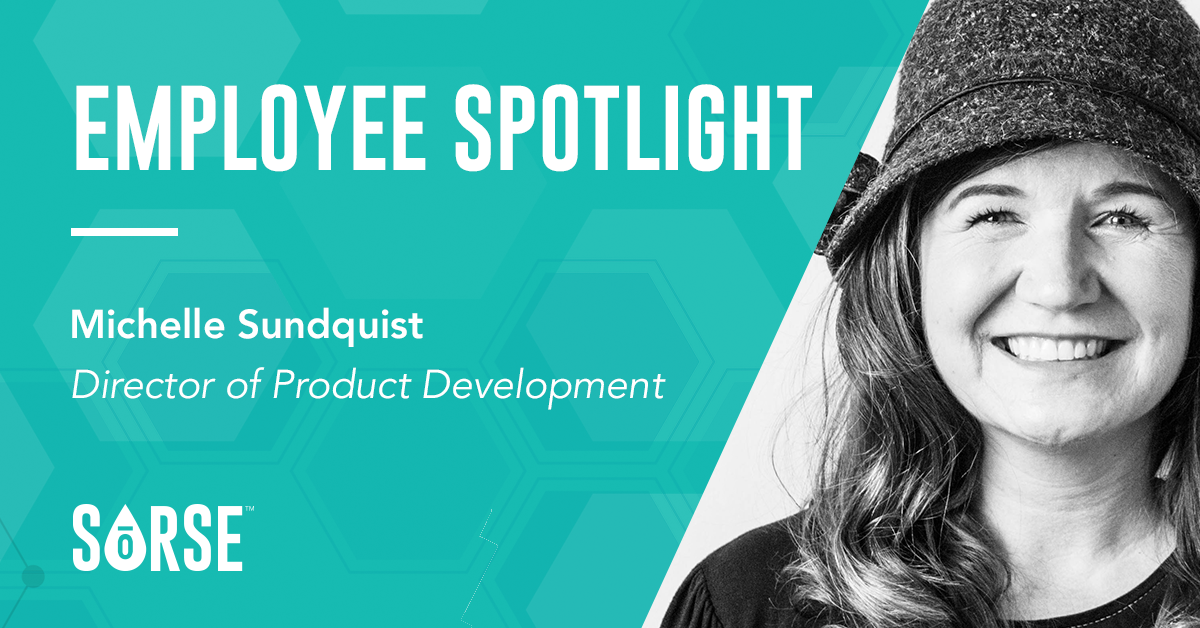Meet our Director of Product Development, Michelle Sundquist, who brings over 20 years of product development experience in the food and beverage industry to our team. If you have ever wondered who was behind Starbucks cold brew coffee product launch, that was Michelle. Her dedication to creating quality products is evident in the work she does with our customers; she listens carefully to their ideas and helps them clarify and actualize their product vision. Outside of SōRSE, she is an active outdoors-person who loves skiing and scuba-diving and a dedicated Packers fan.
What have been some of the significant moments in your time working at SōRSE?
For the Mad Tasty project, we were able to put together a number of beverages quickly. I think having Ryan Tedder be able to choose something, go into production and move to market so fast is impressive. What I enjoy the most is building the infrastructure for R & D — how projects come in and get approved, and how we approach timelines. As long as you are confident and good at what you do, it’s pretty easy to turn something around quickly and efficiently. I like creating the processes for getting projects done.
In the very beginning when we were creating the emulsion, we had a good product — people liked it, but they didn’t know why they liked it. Once you try it, you become a strong believer in how controllable the experience is. Because we understand the science of the emulsion and have gathered documentation on it, our customers feel confident in our products. It makes me really proud that as a food ingredient company, we have gotten to that place quickly. Having all of the different departments represented that you would typically see in a bigger company also makes me proud — it shows that we are thinking about the big picture.
What is it like working with customers who are trying to figure out how to create and then launch a product? How do you coach them through the process?
It’s really exciting working with customers. When they talk about their products, there is so much passion. There is a big difference between hearing someone talk about something they are excited about and reading about it somewhere. In person, you get pulled into the passion.
When I start talking to someone about a new development project, I like to have them tell me what they want to do in their own words. My goal is to get to know them and their personality through talking to them. From there, I look at the words they are using to describe their product, and think about if those are words they would use in their life in general. After that, you can get a better idea of who the customer is. At the same time, you have to know what the current trends are and what the competition is doing.
Once you get a sense of how the person communicates their ideas and an understanding of the product they are looking to launch, then you can get into the specifics, coaching them through the nitty-gritty, like calorie count, organic, low sugar…. People are very focused on calorie count, but the more calories you allow, the more ingredients you can use. You need to really explore the customer’s reasoning for the decisions they are making for their beverage.
At Starbucks, we were constantly training, particularly in problem-solving, dialing in on the development process and delivering what the customer wants and needs. A lot of this comes down to conversation and communication. We need to think about how we can make the customers’ ideas work while constantly remembering what their goal is. It’s important to explore the “why” — because there could be multiple ways to get to a solution that may work a little better.
When you think about someone who has been a mentor to you or influenced your career positively, who is that person and how did they help you along the way?
There are a number of people who have influenced my career and who I look up to. There are two people in particular I turn to for advice, and each has a unique skillset I gravitate towards.
One is Lani, a Global VP for Beverage at Starbucks. She has the ability to stay incredibly Zen through any situation, which I think is really impressive. A lot of the classes she had us take were around mindfulness, self awareness and understanding how others may work differently, which was something I really appreciated. Mindfulness helps you get in the moment, step back, stay in the moment and reset. The class made me realize that everyone gets stressed and that we have to own it.
Jill is the other mentor I rely on; she is very creative and a very strong food scientist. In my creativity, I am methodical — whereas her creativity comes from all directions, which makes it messy and chaotic. I love to learn from her because it challenges me to think about things in a different way. I’m constantly curious as to which way is a faster or more successful process.
What advice would you give to someone entering this industry?
I would remind them to focus on all of the attributes that make people who work at start-ups valuable to other companies. If you join a company because you enjoy the culture, you have to know that culture can change quickly with the turnover of a few people. If you join a company because of the product they sell, the industry is so new that the products they sell can also change.
I think it is better to not have expectations. What you can expect is to work hard and know that you won’t get a lot of direction, but you’ll have your name on the plane when you get done building it. You also need to have a lot of self-confidence in the work you are doing and be able to figure out if you are being successful or not — you have to be able to assess and evaluate yourself.
You also have to know that there can be chaos anywhere, in any business. At the end of the day, businesses are made up of people, and people can be messes — you have emotions, frustration, newness to the business, and disagreement. Because of that, every business has their struggles.
If you could, what product would you create for consumer use?
If I had the know-how, I would come up with more reusable, compostable packaging. If there is a compostable solution to packaging, companies should be forced to use it.
Can you share a fun fact that not a lot of people know about you?
I met Kurt Cobain once at the Health Department in highschool where I used to volunteer as a Peer Educator. He came by with his daughter Frances and signed a bunch of swag — so I won a pair of hot pink, glow in the dark boxer shorts that he signed.
My husband and I also got married at the top of Whistler and skied down in our outfits together — peak to creek!
Let’s Chat
Want to evaluate our emulsions? We’d love to learn more about your business and work to create a custom solution.
Tell us a little about yourself and we’ll be in touch shortly.
Privacy Policy. All rights reserved 2021.

Let’s Chat
Want to evaluate our emulsions? We’d love to learn more about your business and work to create a custom solution.
Tell us a little about yourself and we’ll be in touch shortly.
Privacy Policy. All rights reserved 2021.

Let’s Chat
Want to evaluate our emulsions? We’d love to learn more about your business and work to create a custom solution.
Tell us a little about yourself and we’ll be in touch shortly.
Privacy Policy. All rights reserved 2021.

A
better
emulsion
Here is our step-by-step guide on water-soluble emulsion technology’s impact on stability.


